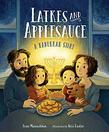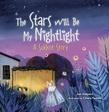In anticipation of Christmas, Hanukkah, and New Year’s, I’ve been revisiting some of my favorites from our roundup of holiday books, among them Latkes and Applesauce: A Hanukkah Story (Charlesbridge, Sept. 27) by Fran Manushkin, illustrated by Kris Easler. This cozy tale follows a family who finds joy on Hanukkah despite heavy snows that prevent them from eating the culinary treats traditionally shared during this holiday. I adore this book and hope families read it together this season, but an insightful Twitter thread from author and librarian Susan Kusel has me considering the imbalance when it comes to books on Jewish holidays: There are comparatively so many more books on Hanukkah, a relatively minor holiday, and so few on the more significant Jewish holidays.
 Kusel, author of The Passover Guest (2021) and a librarian at Temple Rodef Shalom in Falls Church, Virginia, would like to see more books spotlighting Yom Kippur, the Day of Atonement, the holiest day in Judaism. In that Twitter thread, she invited readers to “consider what it would be like if every year, every publisher released dozens of new books on President’s Day. While there were only three out-of-print books in existence on Christmas. While your patrons kept asking for Christmas books.”
Kusel, author of The Passover Guest (2021) and a librarian at Temple Rodef Shalom in Falls Church, Virginia, would like to see more books spotlighting Yom Kippur, the Day of Atonement, the holiest day in Judaism. In that Twitter thread, she invited readers to “consider what it would be like if every year, every publisher released dozens of new books on President’s Day. While there were only three out-of-print books in existence on Christmas. While your patrons kept asking for Christmas books.”
Kusel recently gave me a virtual tour of her library via Zoom. In the sections devoted to holidays, Hanukkah books dominated, followed by Passover books—both holidays are often lumped in with, respectively, Christmas and Easter because of where they fall on the calendar. By contrast, her library has far fewer books on Yom Kippur—as well as other holidays such as Rosh Hashana, Sukkot, and Purim. Kusel emphasizes that there are books about these holidays—indeed, she buys every book she can find on them—but not as many as there could be. Looking over the library’s catalog of Yom Kippur books, for instance, she pulled up just 13 offerings, many of them 20 or 30 years old. Meanwhile, she has more than 200 titles on Hanukkah.
Kusel has over 30 Purim-related books and wishes for many more, as parents often reject some of them. Because the story of Purim involves a character being hanged, it can be difficult to find titles appropriate for young children. “The parents will go through these and [say], ‘Have you seen what’s in these books?’ I know there’s got to be a little more child-friendly way to tell the story.”
The lack of books, Kusel says, has an impact on perceptions of Jewish holidays. “What happens is, one, a lot of people reading these books think that Hanukkah is incredibly significant. And two, they end up not knowing anything about the other Jewish holidays.”
Though there are exceptions, many of the existing books on major Jewish holidays are from small or Jewish-focused presses. But, Kusel says, big publishers, with their larger budgets for distribution and marketing, are especially well positioned to release these titles—and it’s more likely books from larger presses will find an audience, she adds.
However, it can be difficult for authors to sell books on other Jewish holidays. Kusel’s agent, Rena Rossner, never knows for sure why a book is rejected by a publisher. But, she tells me, “I have tried to sell three picture books about Rosh Hashana and a few others that centered other Jewish holidays (like Purim, Shavuot, Sukkot) and was also unsuccessful with those. But I did recently sell both Hanukkah and Passover projects.”
While Kusel believes it’s crucial for Jewish children to see their holidays reflected in their literature, she wants to move away from the assumption that books on Yom Kippur or Rosh Hashana would be niche titles, of interest only to a Jewish audience. Public and school librarian friends have approached her asking for recommendations of books on Yom Kippur because their non-Jewish patrons and students are curious about the holiday.
 Indeed, several of the books I’ve seen this year on Jewish holidays are brimming with appeal whether readers view them as mirrors or windows, to borrow Dr. Rudine Sims Bishop’s phrasing. Jen Halpern’s The Stars Will Be My Nightlight: A Sukkot Story, illustrated by Chiara Fedele (Kar-Ben, Aug. 1), is both a story rooted in cultural traditions and a reassuring tale of familial bonding as a boy and his mother spend the night in their sukkah. Measuring a Year: A Rosh Hashanah Story by Linda Elovitz Marshall, illustrated by Zara González Hoang (Abrams Appleseed, Aug. 16), gently helps young readers conceptualize both Rosh Hashana and Yom Kippur, while Awe-Some Days: Poems About the Jewish Holidays by Marilyn Singer, illustrated by Dana Wulfekotte (Dial Books, Sept. 6), deftly blends verse with informational text for an insightful look at the Jewish calendar.
Indeed, several of the books I’ve seen this year on Jewish holidays are brimming with appeal whether readers view them as mirrors or windows, to borrow Dr. Rudine Sims Bishop’s phrasing. Jen Halpern’s The Stars Will Be My Nightlight: A Sukkot Story, illustrated by Chiara Fedele (Kar-Ben, Aug. 1), is both a story rooted in cultural traditions and a reassuring tale of familial bonding as a boy and his mother spend the night in their sukkah. Measuring a Year: A Rosh Hashanah Story by Linda Elovitz Marshall, illustrated by Zara González Hoang (Abrams Appleseed, Aug. 16), gently helps young readers conceptualize both Rosh Hashana and Yom Kippur, while Awe-Some Days: Poems About the Jewish Holidays by Marilyn Singer, illustrated by Dana Wulfekotte (Dial Books, Sept. 6), deftly blends verse with informational text for an insightful look at the Jewish calendar.
Kusel notes that she is part of an interfaith family and reads Chris Van Allsburg’s The Polar Express (1985) with her children each year. She believes that books on Jewish holidays may well resonate with kids of other cultures, too, and hopes that publishers will begin to take a chance on them. “The thing that we hear a lot is that the only people who are going to buy these books are Jews,” she says. “And Jews do not make up a huge number of the population. But, on the other hand, if we had amazing, beautifully produced, terrific books, how do we know that no one’s going to buy them?”
Mahnaz Dar is a young readers’ editor.



































